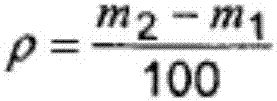Preparation method of polyacrylic acid series water-absorbent resin
A polyacrylic acid-based technology and a manufacturing method, which are applied in the field of water-absorbent resins and their manufacturing, can solve problems such as increasing the cost of raw materials, and achieve the effect of reducing the increase in the cost of raw materials
- Summary
- Abstract
- Description
- Claims
- Application Information
AI Technical Summary
Problems solved by technology
Method used
Image
Examples
Embodiment 1
[0196]3.24 grams of concentration is 6.17wt% azobisisobutylamidine hydrochloride aqueous solution and 5.00 grams of concentration is 4.0wt% sodium persulfate solution mixed under room temperature stirring condition, azobisisobutylamidine hydrochloride and The mass ratio of sodium persulfate is 1:1, and the initiator-foaming agent particle dispersion (particle diameter<45 microns) is obtained, which is ready for use. 200 grams of acrylic acid monomer, 92 grams of deionized water and 244 grams of 32 wt % sodium hydroxide aqueous solution were weighed in sequence and added to a beaker with a volume of 2 liters, stirred evenly and set aside. Subsequently, 4.66 g of polyethylene glycol diacrylate (molecular weight: 522) with a concentration of 11.3 wt % was weighed and added to the partially neutralized monomer solution, and stirred evenly. After heating the monomer solution to 94°C, add the initiator-foaming agent particle dispersion to the monomer solution under agitation to carr...
Embodiment 2
[0199] 6.48 gram concentration is 6.17wt% azobisisobutylamidine hydrochloride aqueous solution and 7.12 gram concentration is 4.0wt% sodium persulfate solution after mixing at room temperature, azobisisobutylamidine hydrochloride and peroxide The mass ratio of sodium sulfate is 1:0.71, and the initiator-foaming agent particle dispersion (particle diameter<45 microns) is obtained, which is ready for use. 200 grams of acrylic acid monomer, 92 grams of deionized water and 244 grams of 32 wt % sodium hydroxide aqueous solution were weighed in sequence and added to a beaker with a volume of 2 liters, stirred evenly and set aside. Subsequently, 4.66 g of polyethylene glycol diacrylate (molecular weight: 522) with a concentration of 11.3 wt % was weighed and added to the partially neutralized monomer solution, and stirred evenly. After heating the monomer solution to 94°C, add the initiator-foaming agent particle dispersion to the monomer solution under agitation to carry out the pol...
Embodiment 3
[0206] The concentration of 1.62 grams of 6.17wt% azobisisobutylamidine hydrochloride solution and 7.12 grams of concentration of 4.0wt% sodium persulfate solution are mixed under stirring at room temperature, azobisisobutylamidine hydrochloride and The mass ratio of sodium persulfate is 1:2.84, and the initiator-foaming agent particle dispersion (particle diameter<45 microns) is obtained, which is ready for use. 200 grams of acrylic acid monomer, 92 grams of deionized water and 244 grams of 32 wt % sodium hydroxide aqueous solution were weighed in sequence and added to a beaker with a volume of 2 liters, stirred evenly and set aside. Subsequently, 4.66 g of polyethylene glycol diacrylate (molecular weight: 522) with a concentration of 11.3 wt % was weighed and added to the partially neutralized monomer solution, and stirred evenly. After heating the monomer solution to 94°C, add the initiator-foaming agent particle dispersion to the monomer solution under agitation to carry o...
PUM
| Property | Measurement | Unit |
|---|---|---|
| particle size | aaaaa | aaaaa |
| particle size | aaaaa | aaaaa |
| particle size | aaaaa | aaaaa |
Abstract
Description
Claims
Application Information
 Login to View More
Login to View More - R&D
- Intellectual Property
- Life Sciences
- Materials
- Tech Scout
- Unparalleled Data Quality
- Higher Quality Content
- 60% Fewer Hallucinations
Browse by: Latest US Patents, China's latest patents, Technical Efficacy Thesaurus, Application Domain, Technology Topic, Popular Technical Reports.
© 2025 PatSnap. All rights reserved.Legal|Privacy policy|Modern Slavery Act Transparency Statement|Sitemap|About US| Contact US: help@patsnap.com



